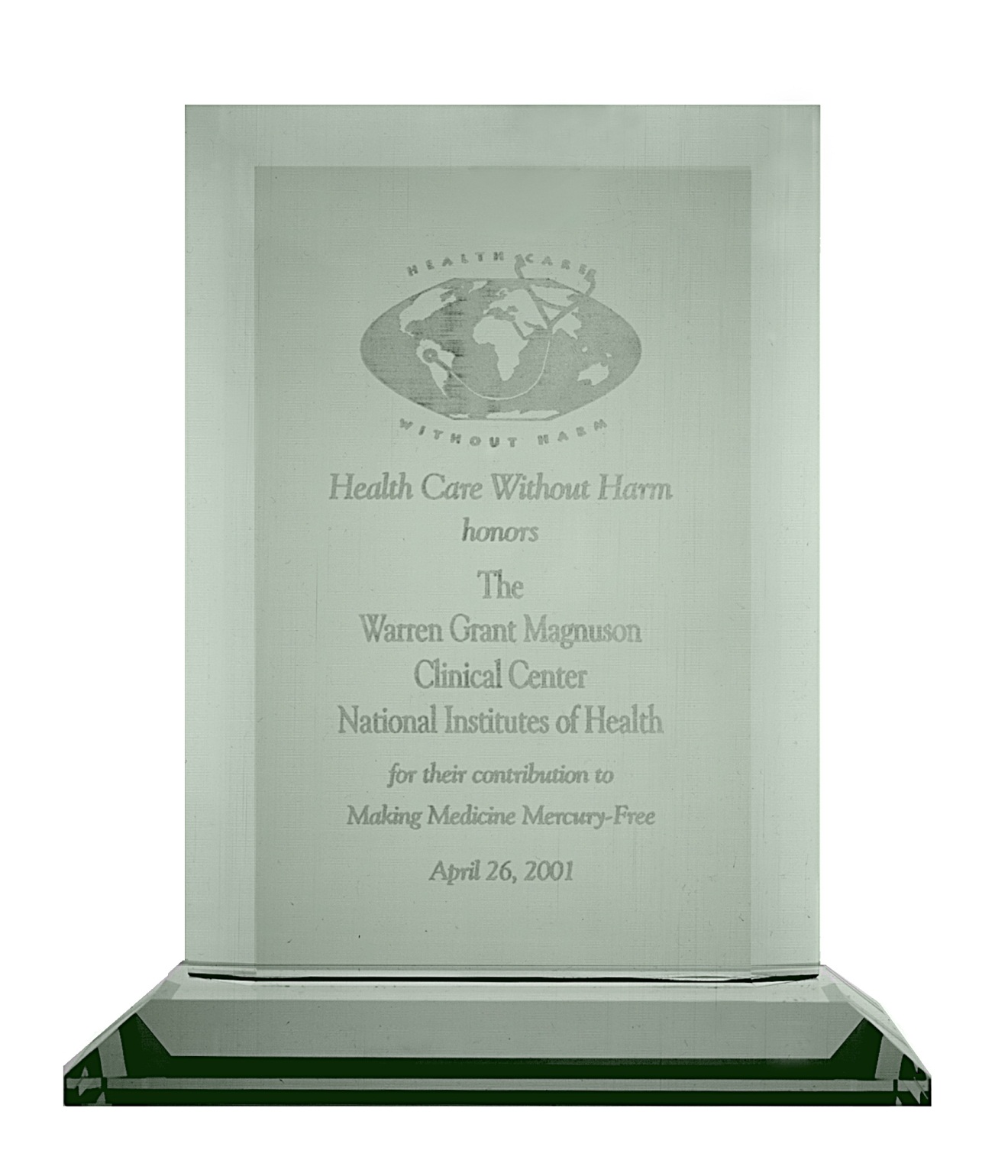The Mad as a Hatter Campaign is a voluntary pollution prevention initiative intended to improve awareness of mercury hazards and eliminate unnecessary uses of mercury and its compounds at all NIH facilities and mission activities.
This campaign was built on the successful mercury elimination efforts of the the mid - 1990's conducted by the Warren G. Magnuson Clinical Center (CC) at the NIH. The CC received this Mercury in Flight Award from the organization Health Care Without Harm (HCWH) for these efforts  and it was the first hospital operated by a federal agency to become mercury free. Paris Glendening, past governor of Maryland cited the campaign as setting "a high standard for environmental outreach and education."
and it was the first hospital operated by a federal agency to become mercury free. Paris Glendening, past governor of Maryland cited the campaign as setting "a high standard for environmental outreach and education."
John E. Porter past chairman of the House Subcommittee on Labor, Health and Human Services, and Education Appropriations, noted that the CC Campaign was an example of the leadership that NIH was taking in reducing the use of environmentally damaging chemicals and that such efforts should pervade the entire research community.
The Mad as a Hatter? Campaign for a Mercury-Free NIH was formally initiated at NIH’s Earth Day and Bring Your Child to Work Day Celebrations held on April 26, 2001 in the CC auditorium. The event featured an educational display, presentations, educational handouts and a confrontation between the Mad Hatter and Mercury Man, the spiritual leader of the fight against mercury sponsored by Health Care Without Harm. (The Mad Hatter lost the confrontation and was escorted out the door). Approximately 1,500 children (Hatter’s Helpers) attended the event. It was also the first and last day of the Campaign as an internal institutional pollution prevention effort. Public interest in the campaign, particularly its Mad Hatter themed outreach materials grew rapidly and these were used by many organizations ranging from local PTAs to the UN Environmental Programme. In late 2002 Paris Glendening, past governor of Maryland cited the campaign as setting "a high standard for environmental outreach and education." In 2005, Captain Ed Rau, the campaign director and a close associate of NIH’s Mad Hatter received the American Chemical Society’s prestigious Howard Fawcett Award for the campaign’s contributions to advancing chemical health and safety. Slides adapted from the award acceptance speech by the Mad Hatter 
It is interesting to note that research on the health effects of mercury performed at NIH in the late 1930’s, probably in Building 2 of our Bethesda Campus, was a primary basis for the ban on the use of mercury in felts that were used in hat making. The ban was put in place by the U.S. Public Health Service on December 1, 1941 just several days before the attack on Pearl Harbor.
The recent history of the campaign and its potential applications in health initiatives to reduce public exposure are reviewed in this Journal of Chemical Health and Safety Article (pdf) 
What do we mean by "mercury-free"?
The intent of this campaign is to eliminate all unnecessary uses of mercury on our facilities and reduce human exposure to potential releases of mercury to the environment from unavoidable uses to the lowest level that can be reasonably be achieved. There are some limited uses of mercury in biomedical research, medicine and facility infrastructure for which there are presently no satisfactory alternatives. Our mercury policy includes procedures for obtaining exceptions to the bans on procurement and use of mercury and its compounds.
Hatter’s Pledge
History of Mad Hatters – Why were Hatters MAD?
In Alice in Wonderland (1865), Lewis Carroll selected a hat maker as the demented host for the tea party. Hatters of the time commonly exhibited slurred speech, tremors, irritability, shyness, depression and other neurological symptoms; hence the expression "mad as a hatter." Carroll was probably unaware that the hatter's disabilities were symptoms of mercury poisoning. In the mid-1800s hat makers used hot solutions of mercuric nitrate to shape the wool used in making hats. They typically worked in poorly ventilated rooms leading to chronic occupational exposure to mercury and neurological damage that followed.
Mercury Home